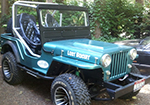I wrote up an article last month on how to identify VEC CJ-2As. It’s a general starter guide for people unsure of how to tell the difference between an early 2A and a later one. Or put more accurately, they are the strategies I use.
http://sellajeep.com/articles/vec-cj2a/vec-cj2a-identify.html
Naturally, after completing and sending said essay to Mark Smith, I subsequently learned that the VEC body issue is even more complicated than I understood it to be. The reason has to do with Willys-Overland’s knack for randomly (probably random anyway) installing some early jeeps with tool-indent bodies, while using non-tool-indent bodies on other jeeps. The assemblers probably just used what bodies they had on hand. That’s why it is also important to track the body’s ACM number. Sean explains to we-who-thought-we-knew-what-we-were-talking-about the issue here: http://www.ewillys.com/2015/04/21/1946-cj-2a-springfield-mo-2950/#comments.


Good morning Dave just wanted to say I thought your piece on the Jeep CJ2A VEC was very good and also points out the random factor involved with changes in parts during production. Presently I now have 3 1945VECs . I think this has been pointed out before and most recently by Sean the lack of absolutes when dealing with batches of parts beeing sent to the assembly line without regards to any order , example using oldest parts first. Thats why body numbers and engine numbers are close but not the same, some higher some lower. It’s just a great hobby if you don’t let the self appointed experts ruin it for you.
Thanks Peter. I appreciate that feedback!
Good article Dave. I wonder why they dropped the glove box. Seems like it would have been a handy feature to keep.
I guess you have been staring at CJ-2A’s too long when you can recognize it in Photos. I can tell #10026 from the Chrysler collection by the Capstan Winch warning plate on the dash that does not belong there, and the repop gauges.
Yes, there were engine changes and body changes that were not done using FIFO due to plant process. (lowest tub# went in the trailer first at ACM but came out and got used first at Willys). There were buyback parts like engine blocks and generators. There were engines diverted for the parts department or production of fire pumps, generators, or Kermath Sea Jeeps. There were tubs with no toolbox (or tool slots after they reportedly ended) under the seat due to anticipated welder Jeep and compressor Jeep production models at Middlekauf down the road in Toledo east of the plant.
These changes, and the exceptions were documented by Willys with deviation permits, change orders, and production release forms. Some of these documents survived, others didn’t.
Hi Keith thanks for the info. Makes sense for sure with the body numbers. As for the Jeep pictured I also recognize it.